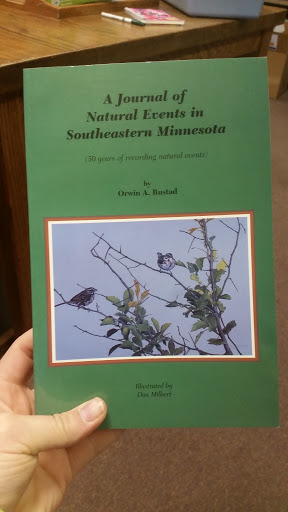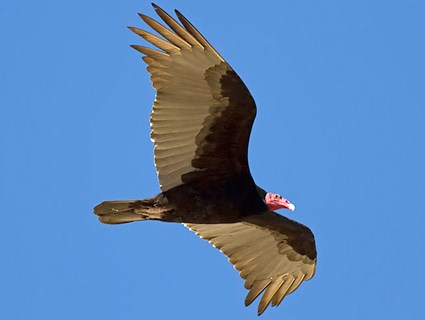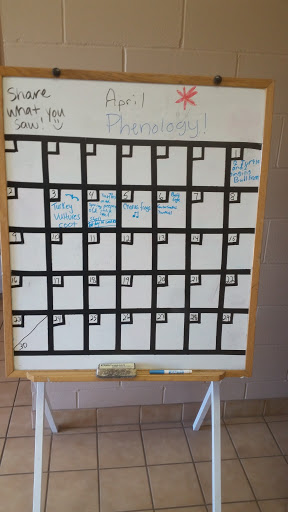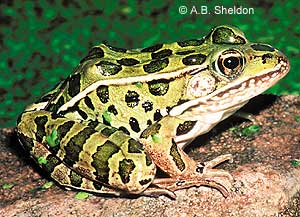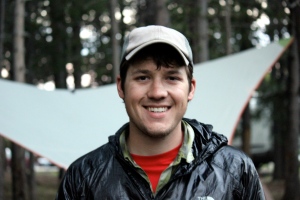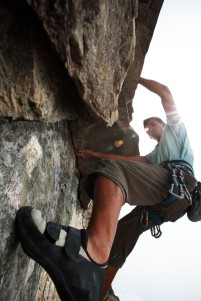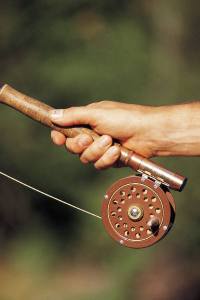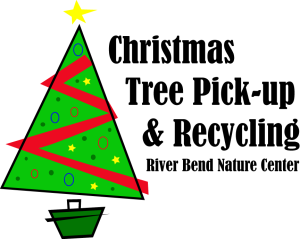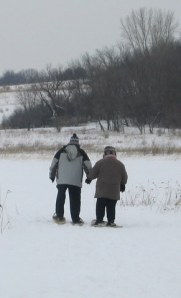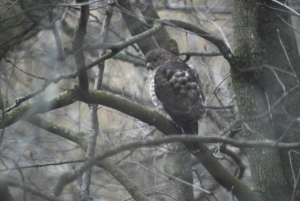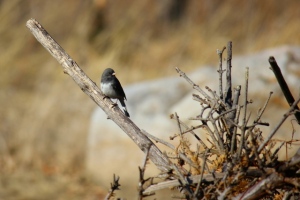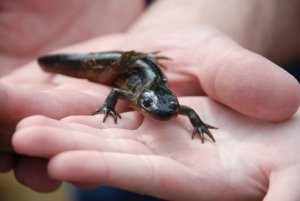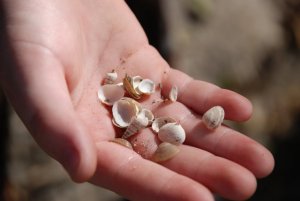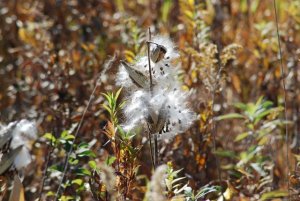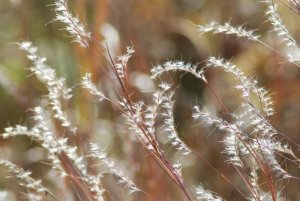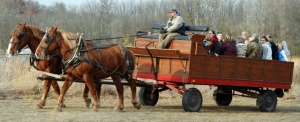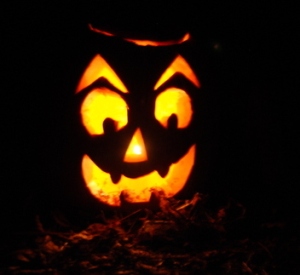“Growing up Monarch” is an on-going segment in the River Bend blog that follows the lives of several monarch butterflies as they grow from egg, to caterpillar, to chrysalis, to adult. We’ll be updating with photos and fun facts and observations throughout the summer!
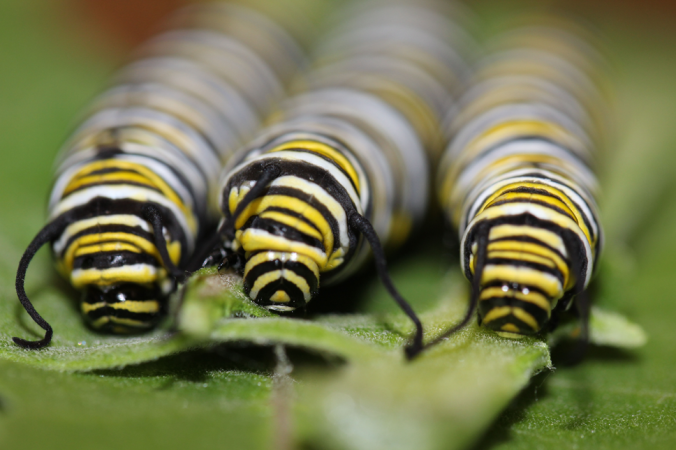
All three River Bend caterpillars are 5th instars. Photo credit: Stephanie Rathsack
Another week has gone by and our three resident monarchs have grown an immense amount! When last we checked in, they were all what is known as 4th instars, meaning that they had shed their skins three times, and would have several distinct features: bold yellow triangles on their heads, “chunkier” bodies with dark banding, and long front tentacles (antennae) that go beyond their head capsules. By Friday the 9th all three caterpillars had shed once again and become 5th instars.

When shedding and during windy days a monarch caterpillar will produce silk (similar to spiders) in order to anchor itself to the leaf. Silk is one of the strongest natural fibers and it’s thought that pound for pound it is stronger than steel. Photo credit: Stephanie Rathsack
As 5th instars our caterpillars are in their final stage as larvae. This means that within just a few short days they’ll be preparing to pupate. The 5th instar stage is marked as being the largest of all the stages, and their front tentacles will be extremely long, becoming noticeably “droopy” past the head capsule. Another key feature though sometimes more difficult to distinguish is a velvety appearance to the black stripes along their bodies.

The black stripes on 5th instars are very large and almost velvety in appearance.
Photo credit: Stephanie Rathsack
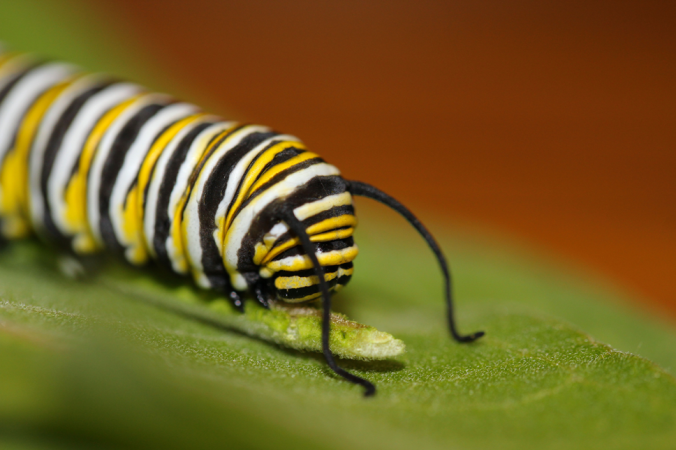
The front tentacles of 5th instars are extremely long and are distinctively droopy towards the ends. Photo credit: Stephanie Rathsack

The facial markings of 5th instars are bright and clearly visible. Note the large triangle in the center. Photo credit: Stephanie Rathsack


Between May 30th (2nd instar) and June 10th (5th instar), just 12 days apart, our caterpillars have dramatically increased in size. Photo credit: Stephanie Rathsack
And while the caterpillars at this stage are very close to completing their time as larva, they still have a little bit of growing to do and a little bit of weight to gain and so of course that means…more eating! They have continued to feed almost nonstop (except to molt and produce frass). However, this constant feeding is noticeably slowing compared to their feeding habits as 3rd and 4th instars. More often they can be seen resting on the leaves—perhaps preparing their bodies for the big changes that are about to occur. In fact, scientists have dissected caterpillars at this stage to discover that several butterfly organs are already starting to form. And so even though these changes are not visible to us, we can imagine the amount of energy it would take to go from an animal that crawls on the ground to one that is capable of flying up to 2,000 miles (anyone would need a nap!).

Although nearly full size, the 5th instar caterpillars can still be seen feeding fairly frequently. Photo credit: Stephanie Rathsack
With three caterpillars sharing an enclosure it’s never a surprise when overnight entire leaves will be consumed—not a single scrap being left (not even the stems)—leaving an empty tank with three very hungry caterpillars looking for seconds, thirds, and fourths. For this reason, rearing monarchs can be a very demanding job, requiring frequent trips to collect fresh leaves no matter what the weather may be.

Being larger doesn’t make you invincible. While 5th instars are notably more bold and more likely to explore their environments than their smaller counterparts, they will still consistently take shelter on the undersides of leaves, perhaps to prevent being spotted by predators. Photo credit: Stephanie Rathsack
And while rearing caterpillars can be an immense amount of work, it is also a very rewarding process, allowing you to view them at every stage, and also witness infrequent or short-lived behaviors that would be difficult to spot in the wild if not impossible. One such behavior that the author witnessed on Saturday the 10th was especially interesting. With three large caterpillars all relatively close together it soon became apparent that this species is by no means gregarious, and has no instinct for companionship. Quite the opposite actually—they are notably aggressive towards those of their own kind, behaving in a manner that you would expect to see exhibited towards potential predators and not towards other caterpillars (who are so similar in size and appearance they may as well be identical). When one caterpillar wandered too close to its neighbors, close enough to brush up against them, the former responded by violently thrashing their head towards the intruder. This motion was repeated several times with a clear “back off” message similar to that of a lunging dog, but the recipient of these “attacks” appeared completely oblivious and merely continued on its way. Eventually the trespasser moved along far enough, and it would seem that touch was the catalyst for this behavior, for as soon as contact was removed, all normal activities of feeding resumed as though nothing had happened.

The caterpillar in the center wandered too close to its neighbors and was punished for doing so by both individuals on either side of it. When touched, the caterpillars will rear their heads and lunge at the intruder—perhaps to drive them off.
Photo credit: Stephanie Rathsack
It’s likely that this behavior is completely instinctual, rather than decision-based. It would seem that caterpillars are “wired” to rear up at unexpected physical stimuli, that is, to throw themselves at things that touch them. This would effectively make them look larger (and probably less appetizing) to would-be predators. It’s behaviors such as this that allow these caterpillars to survive their long lives in this vulnerable stage. For while they are toxic, not all animals have learned to associate the bands of black, yellow, and white, with danger, and will therefore feed on monarch larva before finally understanding that they all are unpalatable. This defensive behavior may also tie in with the necessity to roam. As the caterpillars continue to grow they will soon cease feeding altogether, just as they had when preparing to molt. This time however will be different, and the caterpillar will be searching for a very special location.

The large tentacles of 5th instars may be useful in sensing the environment, especially when exploring an unfamiliar location. Photo credit: Stephanie Rathsack

When large enough, the caterpillars will stop eating and begin to move around more—even leaving their host plant entirely in search of a safe place to pupate.
Photo credit: Stephanie Rathsack
It’s important that the location chosen is perfect—protected both from the elements as well as from predators, as the next stage, the chrysalis, is by far the most vulnerable of all its stages. As a chrysalis, the monarch will be completely unable to move or defend itself in any way as it goes through the difficult transformation into butterfly. For this reason, it is immensely difficult to locate monarch chrysalises in the wild. They are often not placed on milkweed plants, and also camouflage well with their surroundings.

Over the course of approximately two to three weeks, a monarch caterpillar will increase its total mass 2000 times. Seen clearly in comparison between a 5th instar and a newly hatched 1st instar.
Photo credit: Stephanie Rathsack

A 5th instar puts on a lot of weight in order to pupate—and their body segments will become especially pronounced. Photo credit: Stephanie Rathsack
Once they have found the perfect spot, the caterpillar must do several things in order to pupate. First, it must start laying down a mat of silk. It would have done this every time it molted as well, as this mat of silk provides a surface on which to grip and adds extra stability. This time the mat is noticeably larger and thicker. The caterpillar will also create a small wad of silk that is much thicker—this will be the point at which it attaches itself during pupation. Caterpillars produce silk similarly to spiders—through an organ known as a “spinneret”. On monarchs it is located beneath the mouth. Silk begins as a liquid produced in the salivary glands after which it is excreted through the spinneret. Upon coming into contact with air, the liquid silk will turn into solid strands which the caterpillar may then place down. Throughout its life as a caterpillar they retain this ability, and it is most often used as a mat when molting, or as a “life line” if the caterpillar were ever to fall off its host plant. After pupating they lose the spinneret, and also the ability to create silk as it will not be needed in the adult stage.

The silver-white strands of silk are clearly seen crisscrossing underneath the caterpillar. Once finished laying down this mat, it will then begin work on a silk pad, visible here as a small white ball located beneath the caterpillar’s head. Photo credit: Stephanie Rathsack

Once the silk pad is completed, the caterpillar will turn around and grip the pad with its back prolegs. Photo credit: Stephanie Rathsack
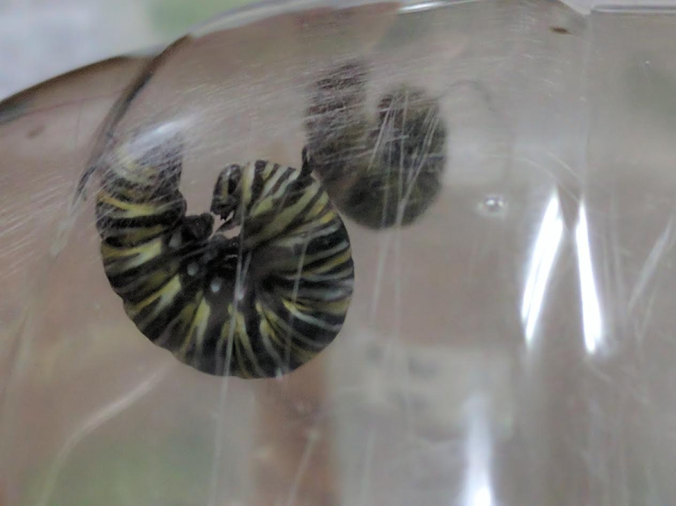
As of the afternoon of June 11th, both larger caterpillars were in the distinctive “J” of pre-pupation, while the third, smaller caterpillar, was still feeding.
Photo credit: Stephanie Rathsack
Upon completion of its silk pad, the caterpillar will use this as a gripping point as it moves into the next stage of pupation. In order to form a chrysalis, the caterpillar will drop its head so that it will be hanging upside down by its back prolegs. They will remain like this for anywhere between 10 and 24 hours, completely unmoving and unchanged—at least on the outside. It couldn’t be further from the case inside. As the hours tick by, the caterpillar will start to move again, appearing to almost be doing sit ups as it will move its head up and down repeatedly. Next, it will appear to grow tired of this movement and hang more loosely, looking less like a J and more like an I. At this point, if you look at its front tentacles carefully, you may notice that they appear shriveled—this is a sign that pupation will soon occur, as there is no longer any “caterpillar” inside that part of its body any longer, and it is ready to molt for the last time. The last sign will be a small tear along the caterpillar’s back, right behind the head. This tear will reveal the bright green of the chrysalis underneath and will grow larger and larger as the skin is worked upwards. This entire process once the skin splits takes just about a minute to complete, so viewing this phenomenon takes not just patience, but also luck and good timing. As the skin continues to come off, more of the chrysalis will be revealed, and many butterfly features will be clearly visible—such as the wings and antennae. When the skin has reached the rear legs, the chrysalis will start twisting around in circles—this serves a duo purpose: one, to remove the old skin completely, and two, to firmly attach itself to the pad of silk. This transition needs to occur quickly, as the caterpillar no longer has back legs to hold onto the silk with. Instead, it must use the cremaster (the black peg on the chrysalis) by hooking it onto the silk. The twisting motion increases the number of strands that hook on, similar to how Velcro works.
By the evening of the 11th both larger caterpillars had pupated and the smallest of the had begun work on its silk pad. Overnight, the smallest caterpillar pupated as well.
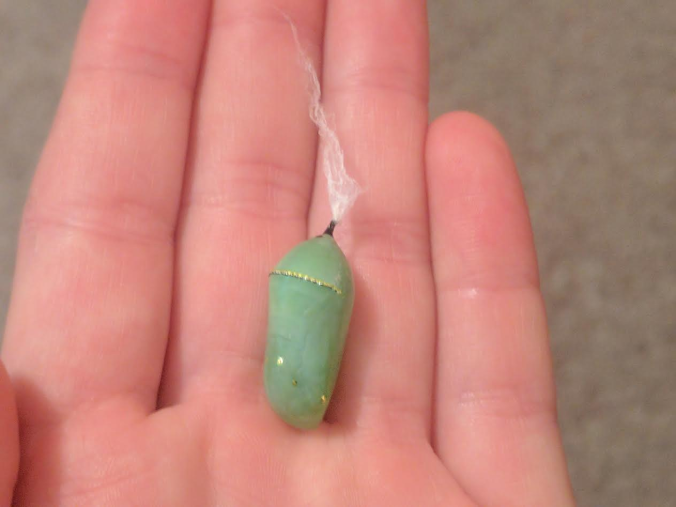
The two first chrysalises were carefully removed from where they had originally pupated in order to be relocated. If you raise your own monarchs, do NOT attempt this without prior experience. Photo credit: Stephanie Rathsack

The morning of Monday the 12th both chrysalises were safely transferred to a new location for easier observation. The 3rd chrysalis had pupated overnight and was still too soft to move. Photo credit: Stephanie Rathsack
Want to learn more?
Stop by our interpretive center this week to talk to a naturalist and see the monarchs for yourself! The monarchs will be available to view:
Mon-Fri 8:00-4:30
Sat 9:00-4:00
Sun 9:00-2:00
Interested in getting more involved?
River Bend will be offering MLMP trainings to teach interested members of the community to become certified MLMP volunteers! Monitor at home or at River Bend, and help save this amazing insect from extinction.
Register online to attend the training scheduled for July 29th 100-4:00pm.
For more information, see our website at: http://www.rbnc.org/
